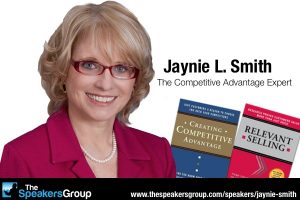 We all know that a key ingredient in any marketing effort should be communicating our competitive advantage or value position to customers. However, Jaynie Smith, author of Creating Competitive Advantage and Relevant Selling, has found in her 20 years of consulting with Fortune 500 companies that the marketing efforts of most companies contain one or more of five fatal flaws.
We all know that a key ingredient in any marketing effort should be communicating our competitive advantage or value position to customers. However, Jaynie Smith, author of Creating Competitive Advantage and Relevant Selling, has found in her 20 years of consulting with Fortune 500 companies that the marketing efforts of most companies contain one or more of five fatal flaws.
Are you ready to put your own marketing messaging to the test? Here are the five fatal flaws to beware of:
1. They don’t have a competitive advantage, but they think they do.
Actually, it’s not that the company doesn’t have a competitive advantage, but what they’re stating as their competitive advantage really isn’t one… leaving their prospective customers respond with a, “So what?” When Jaynie spoke with Shawn Ellis, founder of The Speakers Group, on “The Better Life/ Better Business Podcast,” she stated that the truth of the matter is, “In my work, I have not yet found a company that didn’t have competitive advantages… They just don’t know what they are” — which happens to be the second fatal flaw.
2. They have a competitive advantage, but they don’t know what it is – so they lower prices instead.
If you don’t know what your competitive advantages are and you listen to what your customers say–without researching customer issues on your own–you may conclude that price is the most important competitive advantage. As Jaynie says, companies “let themselves be painted into commodity corner” and they lower their prices because they think that is what they must do to compete. Lowering the price may not be the answer, and it may not necessarily attract customers if a competitor offers something that customers value more than low prices. Customers may not realize that there are things that they value more than low prices–but there are.
3. They know what their competitive advantage is, but they neglect to tell customers about it.
Some companies do know what their competitive advantages are, but either they don’t convey that message in their marketing and in sales contacts with customers, or else they convey the message, but they don’t convey it effectively. Companies who fail to clearly define and articulate their competitive advantage for their salespeople and their customers may find that each one of their salespeople is presenting a different, inconsistent presentation of those advantages for customers. In other cases, an inarticulate marketing plan may present a tepid or even a generic, “me too” version of the message. Jaynie Smith calls this the “ditto syndrome.” To counter the ditto syndrome, she suggests in her blog for her consulting business, Smart Advantage:
Test your message. Get some agreement internally as to what you think your customers and prospects value in their buying decision. Then explore your website for how you communicate those “deliverables.”
Next, view the websites of your top competitors. Look for content message similarities. We often find the content so similar, we joke that all the competitors must have the same web design company. It would be funny if the messaging wasn’t dangerously homogenous.
4. They mistake “strengths” for competitive advantages.
Every business knows to do a “SWOT” analysis (an analysis of strengths, weaknesses, opportunities, and threats). However, the strengths listed in the SWOT analysis are not necessarily competitive advantages. Often, they are only basic attributes that the company and all of its competitors must have in common in order to attract customers and stay in business – quality, reliability, good reputation, experienced and knowledgeable employees, good customer service. Such basic attributes only become competitive advantages when a business is better at one or more of them and can prove it to customers with factual statements.
5. They don’t concentrate on competitive advantages when making strategic and operational decisions.
In her interview on “The Better Life/ Better Business Podcast,” Jaynie Smith stated, “…Peter Drucker said that 90 percent of the information we use in making decisions comes from the inside, not the outside, which is exactly backwards. We need to find out what our customers value, not what they think they should value, and that is a big, big dangerous mistake that companies make.”
In her blog for her consulting business, Smart Advantage, Jaynie suggests taking a “disciplined approach to gaining and/or acting on the customer perspective.” She suggests a series of talking points for an internal business discussion that will separate internal opinions from the actual facts about what competitive advantages are truly important to customers.
Now that you know what to look for, avoiding these flaws can help you spotlight your true competitive advantage.